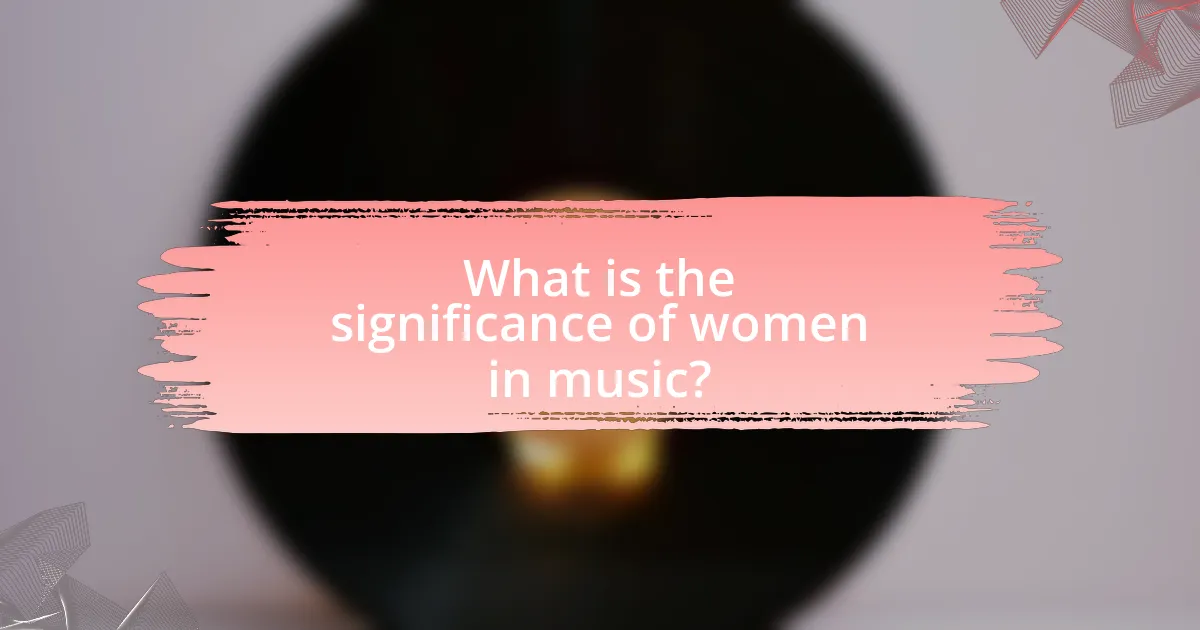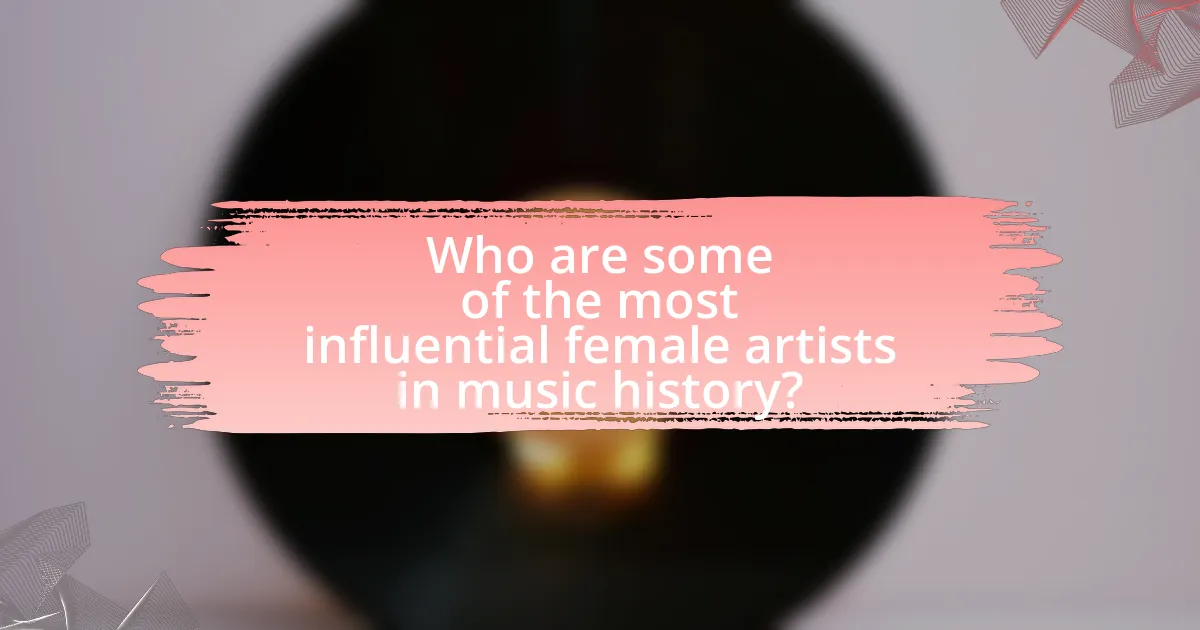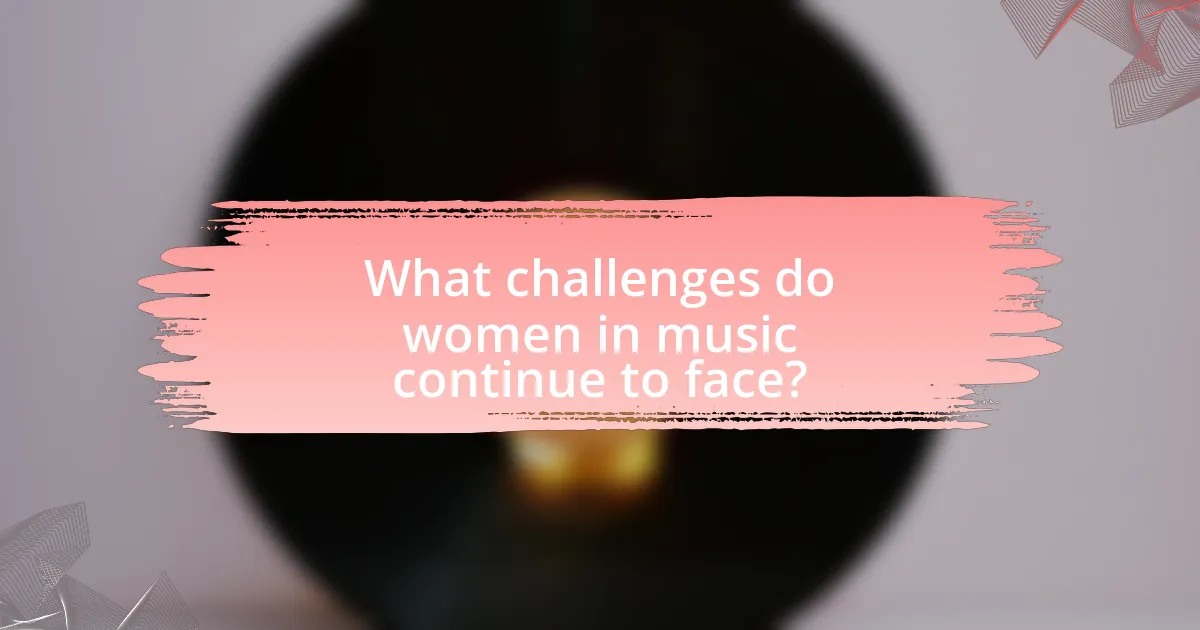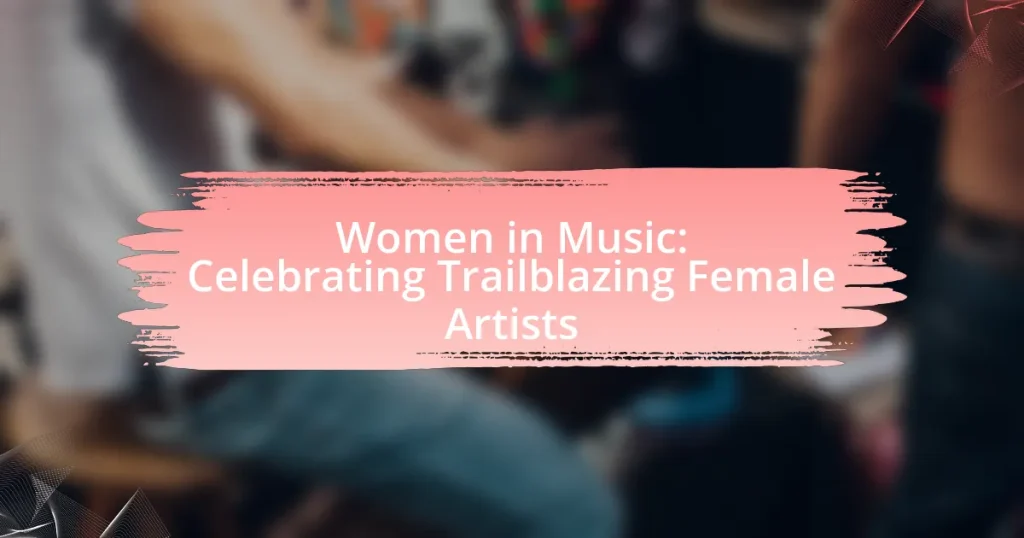The article “Women in Music: Celebrating Trailblazing Female Artists” highlights the significant contributions of women in the music industry, emphasizing their roles in shaping genres, challenging societal norms, and promoting social change. It discusses historical barriers faced by female artists, their influence across various music genres, and the importance of recognizing their achievements to inspire future generations. The article also addresses ongoing challenges such as gender inequality, underrepresentation, and the need for initiatives that support women in music, while showcasing contemporary artists who are redefining industry standards.

What is the significance of women in music?
Women in music play a crucial role in shaping genres, influencing cultural movements, and promoting social change. Historically, female artists have challenged societal norms and provided diverse perspectives, contributing to the evolution of music across various styles, from jazz and rock to hip-hop and pop. For instance, artists like Aretha Franklin and Madonna not only achieved commercial success but also became symbols of empowerment and resistance against gender inequality. Their impact is evident in the increasing representation of women in music, with studies showing that female artists accounted for 22.5% of the Billboard Hot 100 in 2020, highlighting their growing presence and influence in the industry.
How have female artists shaped the music industry?
Female artists have significantly shaped the music industry by breaking barriers, influencing genres, and redefining cultural norms. For instance, artists like Aretha Franklin and Madonna not only achieved commercial success but also challenged societal expectations regarding women’s roles in music. Aretha Franklin’s powerful voice and activism in the civil rights movement helped elevate the importance of female perspectives in music, while Madonna’s reinvention of pop music and her embrace of sexuality empowered women to express themselves freely. Additionally, statistics show that female artists now dominate various music charts, with women accounting for 50% of the top 10 Billboard Hot 100 songs in 2020, illustrating their impact on contemporary music trends.
What historical barriers have women faced in music?
Women in music have historically faced barriers such as societal norms, lack of access to education, and gender discrimination. Societal norms often relegated women to domestic roles, limiting their opportunities to pursue music professionally. Additionally, women were frequently excluded from formal music education and performance venues, which hindered their development and visibility in the industry. Gender discrimination manifested in various ways, including the undervaluation of women’s contributions and the prevalence of male-dominated music scenes, which often sidelined female artists. For instance, in the 19th century, women composers like Clara Schumann struggled for recognition in a field dominated by male counterparts, illustrating the systemic challenges they faced.
How have female musicians influenced various genres?
Female musicians have significantly influenced various genres by introducing innovative styles, themes, and perspectives that have reshaped the music landscape. For instance, artists like Aretha Franklin and Billie Holiday transformed soul and jazz with their emotive vocal techniques and personal storytelling, paving the way for future generations. In rock, figures such as Joan Jett and Stevie Nicks challenged gender norms and inspired countless female musicians to enter a male-dominated field. Additionally, in hip-hop, artists like Missy Elliott and Nicki Minaj have expanded the genre’s boundaries by incorporating diverse lyrical content and unique performance styles, thus influencing both the sound and cultural significance of hip-hop. The impact of these female musicians is evident in the continued evolution of genres, as they have not only contributed to musical innovation but also advocated for social change and representation within the industry.
Why is it important to celebrate trailblazing female artists?
Celebrating trailblazing female artists is important because it acknowledges their significant contributions to the arts and promotes gender equality in creative fields. Female artists have historically faced barriers and underrepresentation, yet many have pioneered new genres and styles, influencing the music industry and culture at large. For instance, artists like Aretha Franklin and Madonna not only shaped their respective genres but also challenged societal norms regarding women’s roles in music. Recognizing their achievements inspires future generations of female artists, fosters diversity, and encourages a more inclusive artistic landscape.
What impact do these artists have on future generations?
Trailblazing female artists significantly influence future generations by breaking barriers and redefining societal norms in the music industry. Their achievements inspire young women to pursue careers in music, fostering a culture of empowerment and creativity. For instance, artists like Aretha Franklin and Madonna have not only achieved commercial success but also challenged gender stereotypes, paving the way for future female musicians. Research indicates that representation in media, including music, positively affects the aspirations and self-esteem of young girls, as highlighted in a study by the Geena Davis Institute on Gender in Media, which found that female role models in entertainment lead to increased ambition among girls.
How does recognition of female artists promote diversity in music?
Recognition of female artists promotes diversity in music by expanding the range of voices and perspectives represented in the industry. When female artists gain visibility, they challenge traditional gender norms and introduce varied musical styles, themes, and narratives that reflect different experiences. For instance, studies show that female musicians often address social issues, personal struggles, and cultural identities in their work, which enriches the overall musical landscape. Furthermore, the inclusion of female artists in mainstream platforms leads to a more equitable representation, encouraging emerging female talent and fostering a more inclusive environment in the music industry. This shift not only diversifies the types of music produced but also influences audience perceptions and expectations, ultimately contributing to a richer cultural dialogue.

Who are some of the most influential female artists in music history?
Some of the most influential female artists in music history include Aretha Franklin, Madonna, and Billie Holiday. Aretha Franklin, known as the “Queen of Soul,” significantly impacted the music industry with her powerful voice and emotive performances, earning 18 Grammy Awards and influencing countless artists across genres. Madonna, often referred to as the “Queen of Pop,” revolutionized the music scene with her innovative approach to music and fashion, selling over 300 million records worldwide and shaping pop culture since the 1980s. Billie Holiday, a pioneering jazz and blues singer, is celebrated for her unique vocal style and emotional depth, leaving a lasting legacy on music and inspiring future generations of artists.
What contributions did early female musicians make?
Early female musicians significantly contributed to the development of various music genres and the representation of women in the arts. Notable figures such as Clara Schumann and Fanny Mendelssohn broke societal barriers by composing and performing music during the 19th century, which was predominantly male-dominated. Their works not only enriched the classical repertoire but also paved the way for future generations of female composers and performers. Additionally, women like Bessie Smith and Ma Rainey were instrumental in the evolution of blues music, influencing countless artists and shaping the genre’s identity. These contributions highlight the essential role early female musicians played in diversifying musical expression and challenging gender norms in the music industry.
Who were the pioneers of women in jazz and blues?
The pioneers of women in jazz and blues include Bessie Smith, Billie Holiday, and Ella Fitzgerald. Bessie Smith, known as the “Empress of the Blues,” was a leading figure in the 1920s and significantly influenced the genre with her powerful voice and emotive performances. Billie Holiday, active from the 1930s to the 1950s, brought a unique style and emotional depth to jazz, becoming one of the most celebrated vocalists of her time. Ella Fitzgerald, often referred to as the “First Lady of Song,” was renowned for her exceptional vocal range and improvisational skills, making her a key figure in both jazz and popular music. These artists not only shaped the sound of their respective genres but also paved the way for future generations of female musicians.
How did rock and pop evolve with the influence of female artists?
Rock and pop evolved significantly due to the influence of female artists, who introduced new perspectives, styles, and themes that reshaped the genres. Artists like Janis Joplin and Joan Jett challenged societal norms and brought a raw, emotional authenticity to rock music, paving the way for future generations. In pop, figures such as Madonna and Britney Spears redefined the role of women in the industry, using their platforms to explore themes of empowerment and sexuality. The incorporation of diverse voices and experiences from female artists has led to a broader representation in music, influencing everything from lyrical content to performance styles. This evolution is evident in the rise of genres like pop-rock and the increasing presence of women in leadership roles within the music industry, as seen in the success of female-led bands and solo acts.
Which contemporary female artists are making waves today?
Contemporary female artists making waves today include Billie Eilish, Lizzo, and Dua Lipa. Billie Eilish has gained significant recognition for her unique sound and style, winning multiple Grammy Awards, including Album of the Year in 2020. Lizzo has made headlines with her empowering messages and chart-topping hits like “Truth Hurts,” which topped the Billboard Hot 100 for seven weeks. Dua Lipa has also achieved commercial success with her album “Future Nostalgia,” which received critical acclaim and multiple awards, including the Grammy for Best Pop Vocal Album in 2021. These artists are not only dominating the charts but also influencing cultural conversations around body positivity, mental health, and self-expression.
What are the defining characteristics of their music?
The defining characteristics of their music include a blend of diverse genres, strong lyrical themes, and innovative production techniques. Female artists often incorporate elements from pop, rock, hip-hop, and R&B, showcasing versatility and broad appeal. Lyrically, their songs frequently address personal empowerment, social issues, and emotional experiences, reflecting a deep connection to their audiences. Additionally, many trailblazing female musicians utilize cutting-edge technology and unique soundscapes, pushing the boundaries of traditional music forms. For instance, artists like Björk and Grimes are known for their experimental approaches, which have redefined genre conventions and influenced contemporary music trends.
How are they challenging industry norms and expectations?
Trailblazing female artists are challenging industry norms and expectations by redefining the roles and narratives traditionally assigned to women in music. For instance, artists like Billie Eilish and Lizzo have embraced authenticity and body positivity, directly opposing the conventional standards of beauty and behavior often imposed on female performers. Eilish’s unique style and lyrical content break away from the hyper-sexualization prevalent in the industry, while Lizzo promotes self-love and empowerment, encouraging women to embrace their individuality. These artists not only gain commercial success but also inspire a new generation to challenge societal norms, as evidenced by Eilish winning multiple Grammy Awards and Lizzo’s chart-topping hits that celebrate diversity and self-acceptance.

What challenges do women in music continue to face?
Women in music continue to face significant challenges, including gender discrimination, underrepresentation in leadership roles, and unequal pay. Research indicates that women make up only about 21% of artists in the music industry, highlighting their underrepresentation. Additionally, a study by the Annenberg Inclusion Initiative found that female artists earn less than their male counterparts, with women receiving only 30% of the total revenue generated by the music industry. Furthermore, women often encounter barriers to entry in technical roles, such as production and sound engineering, where they are vastly outnumbered. These challenges persist despite the contributions and successes of female artists, underscoring the need for systemic change within the industry.
How does gender inequality manifest in the music industry?
Gender inequality in the music industry manifests through disparities in representation, pay, and opportunities for women compared to their male counterparts. For instance, a 2021 report by the Annenberg Inclusion Initiative revealed that only 22.4% of artists on the Billboard Hot 100 were women, highlighting significant underrepresentation. Additionally, women in music often receive lower pay; a study by the Music Industry Research Association found that female musicians earn approximately 30% less than male musicians. Furthermore, women face barriers in leadership roles, with only 12.5% of music producers being female, according to a 2020 report by the USC Annenberg Inclusion Initiative. These statistics illustrate the systemic challenges women encounter in achieving equality within the music industry.
What statistics highlight the disparity in representation?
Women are significantly underrepresented in the music industry, with statistics revealing that only 21% of artists on the Billboard Hot 100 are women. Additionally, a study by the Annenberg Inclusion Initiative found that only 12.3% of songwriters and 2.1% of producers in popular music are women. These figures underscore the ongoing gender disparity in representation within the music sector, highlighting the need for increased visibility and opportunities for female artists.
How do societal expectations affect female artists’ careers?
Societal expectations significantly impact female artists’ careers by imposing traditional gender roles that often limit their creative expression and professional opportunities. These expectations can lead to biases in the music industry, where female artists may face pressure to conform to specific images or genres deemed acceptable, such as pop or romantic themes, rather than being recognized for their diverse talents. Research from the University of Southern California’s Annenberg Inclusion Initiative indicates that women are underrepresented in music production and songwriting roles, which further restricts their influence and visibility in the industry. Additionally, societal norms often prioritize male artists, leading to fewer opportunities for female musicians in terms of festival lineups, radio play, and media coverage, ultimately hindering their career advancement.
What initiatives are in place to support women in music?
Numerous initiatives exist to support women in music, including organizations like Women in Music, which provides networking opportunities, educational resources, and advocacy for gender equality in the industry. Additionally, the She Is The Music initiative aims to increase the number of women in music by providing mentorship, funding, and resources for female artists and industry professionals. Research from the Annenberg Inclusion Initiative highlights that women represent only 21.6% of artists in popular music, underscoring the need for such initiatives to promote inclusivity and support for women in the field.
How can organizations promote gender equality in the industry?
Organizations can promote gender equality in the industry by implementing policies that ensure equal pay for equal work, providing mentorship programs for women, and fostering inclusive workplace cultures. Research indicates that companies with gender-diverse leadership are 21% more likely to outperform their counterparts in profitability, highlighting the business case for gender equality. Additionally, organizations can establish clear diversity and inclusion goals, track progress through metrics, and create accountability structures to ensure sustained commitment to gender equality initiatives.
What role do mentorship and networking play in supporting female musicians?
Mentorship and networking play a crucial role in supporting female musicians by providing guidance, opportunities, and community connections that are often lacking in a male-dominated industry. Female musicians who engage in mentorship can gain insights from experienced artists, which helps them navigate challenges and enhance their skills. Networking allows these musicians to build relationships with industry professionals, leading to collaborations, performance opportunities, and increased visibility. Research indicates that women in music benefit significantly from mentorship programs, as they report higher levels of confidence and career advancement. For instance, a study by the Berklee College of Music found that female artists with mentors are more likely to secure record deals and gain recognition in their fields.
What can we do to further support women in music?
To further support women in music, we can implement mentorship programs that connect emerging female artists with established professionals in the industry. Research shows that mentorship significantly enhances career development, as evidenced by a study from the National Endowment for the Arts, which found that artists with mentors are more likely to achieve higher levels of success and recognition. Additionally, increasing funding for female-led music initiatives and festivals can provide platforms for women to showcase their talents, as demonstrated by the success of events like the Women’s Music Festival, which has increased visibility for female artists and contributed to their career growth.
How can audiences contribute to the success of female artists?
Audiences can contribute to the success of female artists by actively supporting their work through attendance at live performances, purchasing their music, and promoting their content on social media platforms. This support directly impacts female artists’ visibility and financial stability, as ticket sales and music purchases are crucial revenue streams. For instance, a study by the University of Southern California found that increased audience engagement can lead to higher chart performance and streaming numbers for female artists, demonstrating the tangible effects of audience support on their success.
What are some best practices for promoting gender equality in music?
Best practices for promoting gender equality in music include implementing equitable hiring practices, ensuring diverse representation in decision-making roles, and providing mentorship programs for women artists. Research indicates that organizations with diverse leadership are 35% more likely to outperform their peers, highlighting the importance of inclusive practices. Additionally, initiatives like the 50/50 by 2020 campaign aim to achieve gender parity in music festivals, demonstrating a commitment to equal opportunities.

